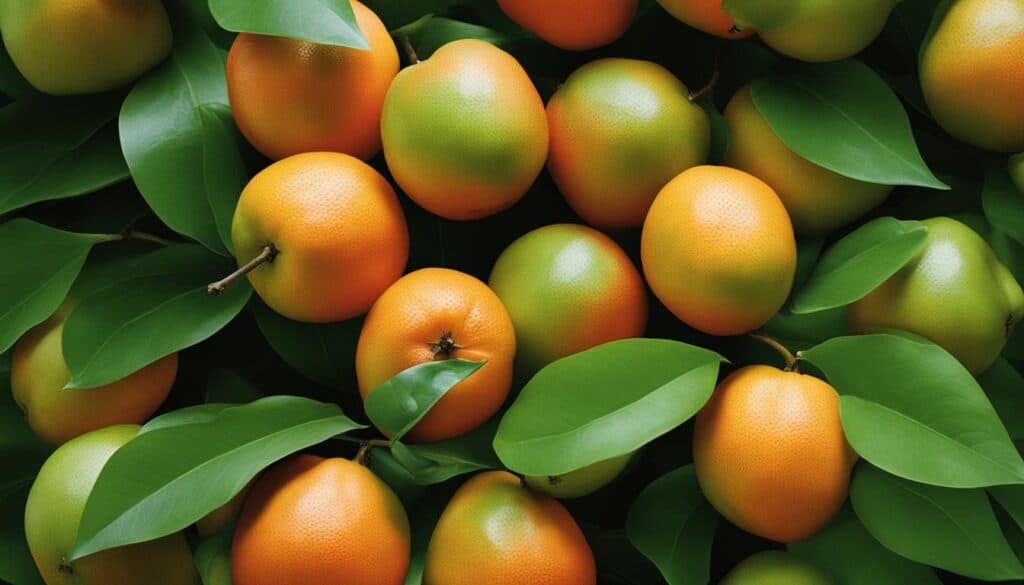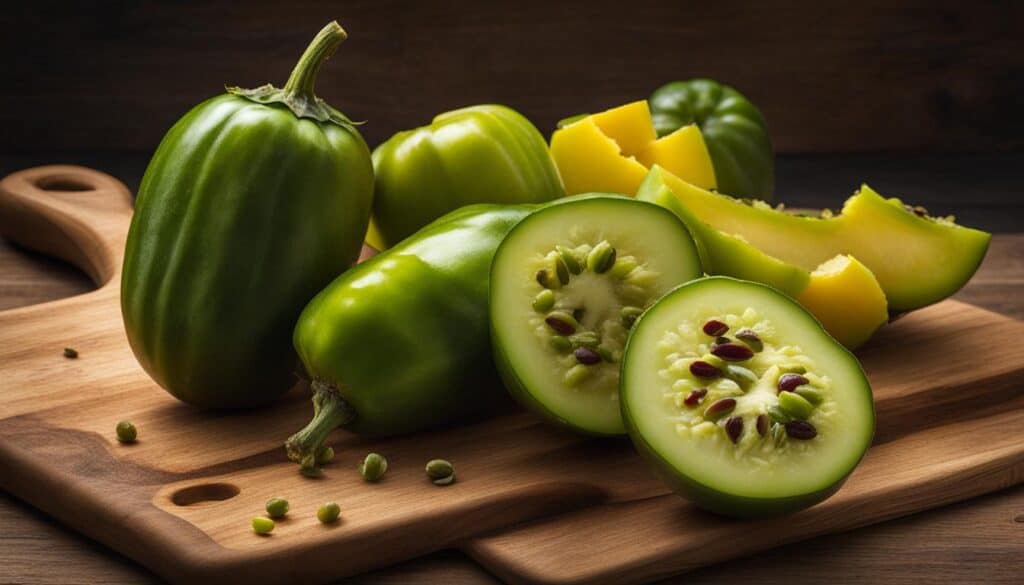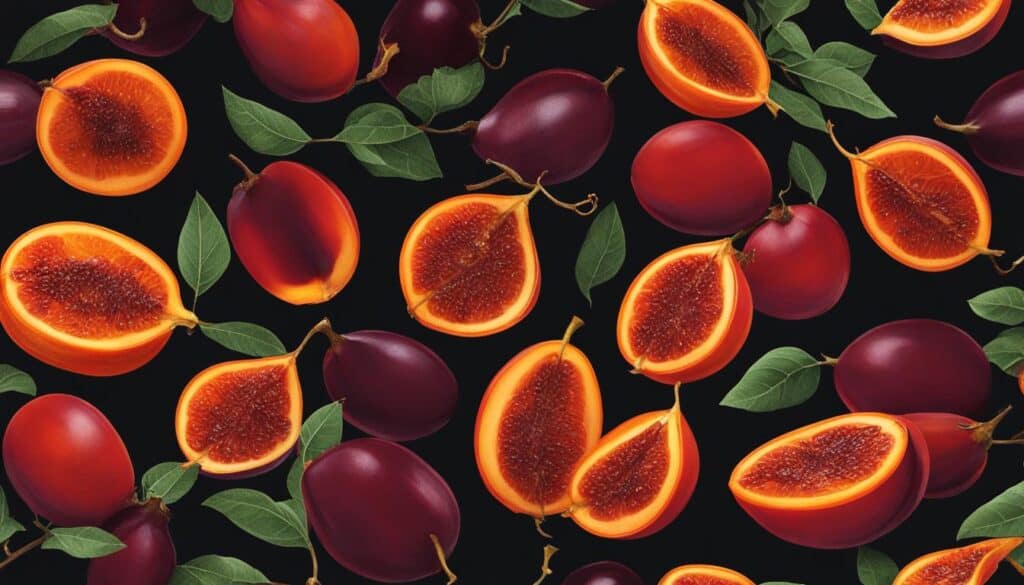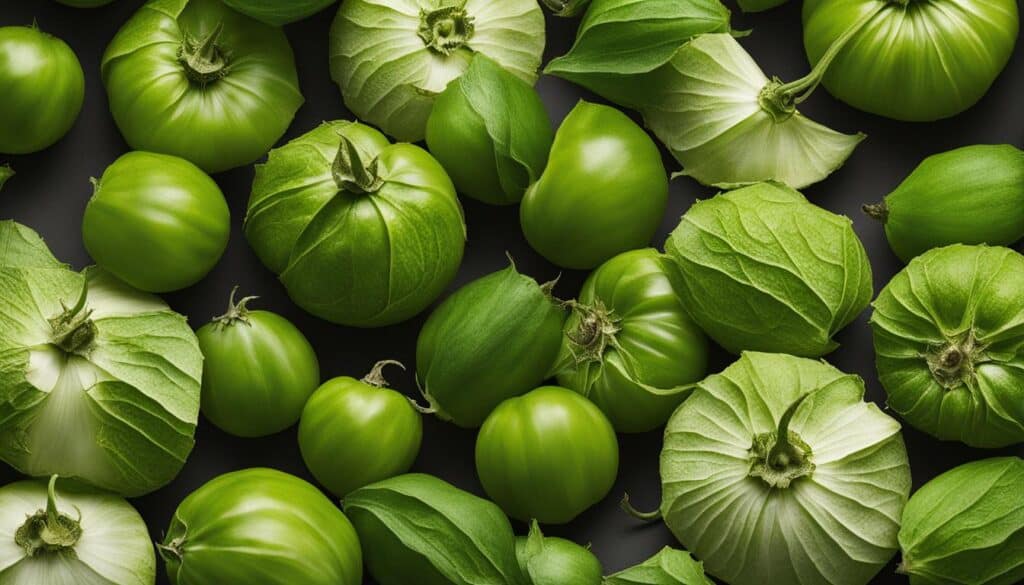Tomatoes are a versatile fruit used in various culinary dishes worldwide. However, if you’re looking for tomato substitutes or fruits that resemble tomatoes in appearance and taste, you’re in luck! In this guide, I’ll introduce you to a variety of fruit options that share similarities with tomatoes but offer unique flavors and culinary possibilities.
Whether you’re searching for a tomato substitute in a specific recipe or looking to experiment with new flavors, exploring these tomato-like fruits can add excitement to your cooking. Get ready to discover unique fruit options that will elevate your dishes and inspire your culinary creativity.
Key Takeaways:
- There are several fruits similar to tomatoes in appearance and taste.
- Ground cherries have a tangy flavor that resembles a mix of pineapple and tomato.
- Persimmons offer a sweet and honey-like flavor as an alternative to tomatoes.
- Sharon fruit, also known as kaki, has a dense flesh similar to mango or peach and is often used in desserts.
- Pepino is a sweet fruit with a texture similar to pear or cantaloupe and a flavor reminiscent of melon or cucumber.
Stay tuned for the remaining sections of this guide, where I’ll introduce you to more tomato-like fruits that are sure to surprise and delight your taste buds.
Ground Cherry (Physalis pruinosa)
When it comes to tomato lookalike fruits, the ground cherry is a delightful option to explore. Resembling a cherry tomato, this small yellow fruit adds a unique tangy taste to your dishes, setting it apart from its savory counterpart. In fact, its flavor is reminiscent of pineapples, offering a refreshing twist to your culinary creations.
Ground cherries are incredibly versatile and can be used in a variety of sweet recipes. Whether you’re baking cakes, making pies, preparing jams, or experimenting with chutneys, these tomato-like fruits bring a tangy sweetness that can elevate the flavors of your desserts.
But it’s not just about the taste. Ground cherries also pack a nutritional punch. They are a good source of vitamin C, potassium, and fiber, making them a healthy choice for your diet. Incorporating ground cherries into your cooking not only enhances the flavor but also adds a nutritious boost to your meals.
Discover the irresistible tangy taste of ground cherries – a versatile tomato substitute fruit that adds a delightful twist to your recipes.
Persimmon (Diospyros virginiana)
The persimmon is a delightful fruit that resembles a tomato in appearance but offers a sweet and enchanting taste. Its honey-like flavor and dense texture set it apart from the savory tomato.
Persimmons come in two main varieties – astringent and non-astringent. Both types can be used in a wide range of culinary creations, both sweet and savory. These versatile fruits are a fantastic addition to desserts, salads, sauces, and even main dishes, adding a unique touch to your recipes.
Not only does the persimmon provide a burst of sweetness, but it is also a nutritional powerhouse. Rich in vitamins A and C, fiber, and antioxidants, persimmons offer a healthy addition to your diet. Incorporating this sweet fruit into your meals can provide a refreshing and nutritious boost.
Benefits of Persimmon:
- High in vitamins A and C, promoting skin health and boosting the immune system.
- Fiber-rich, aiding in digestion and promoting a healthy gut.
- Packed with antioxidants, protecting the body from harmful free radicals.
To fully appreciate the beauty and flavor of a persimmon, try incorporating it into recipes such as:
- Persimmon tart with a buttery crust
- Refreshing persimmon salad with arugula and goat cheese
- Sticky and sweet persimmon chutney to accompany your favorite cheese
- Warm and comforting persimmon bread pudding
“The persimmon’s exquisite flavor adds a touch of natural sweetness to any dish, making it a perfect choice for both sweet and savory culinary adventures.”
| Vitamin Content per 100g | Astringent Persimmon | Non-Astringent Persimmon |
|---|---|---|
| Vitamin A | 81 IU | 81 IU |
| Vitamin C | 72.7 mg | 7.5 mg |
| Antioxidant Value | 3,811 µmol TE/100g | 1,477 µmol TE/100g |
| Fiber Content | 3.6 g | 3.6 g |
Sharon Fruit: A Sweet Delight for Desserts
When it comes to tomato-like fruits, one that stands out is the Sharon fruit, also known as kaki or “Chinese persimmon.” Resembling a tomato in shape, this delightful fruit has a dense flesh akin to that of a mango or peach. With its sweet flavor and versatile culinary applications, Sharon fruit is a staple in many dessert dishes.
Sharon fruit is often mistaken for persimmons due to their similar appearance. However, they are distinct species with their own unique characteristics. The luscious flesh of Sharon fruit sets it apart, making it a preferred choice for those seeking a truly indulgent dessert experience.
One of the ways to appreciate the delectable taste of Sharon fruit is by enjoying it fresh. Its rich, sweet flavor is enhanced when the fruit is at its peak ripeness – a perfect combination of sweetness and juiciness that will leave your taste buds craving for more.
Not only does Sharon fruit provide a burst of sweetness, but it also offers a variety of health benefits. It is a good source of vitamins A and C, as well as dietary fiber. These nutrients contribute to a healthy diet and can support overall well-being.
“The dense flesh of Sharon fruit, coupled with its natural sweetness, makes it an excellent choice for various dessert concoctions.” –
Richard Thompson, Pastry Chef
Sharon Fruit Recipes
Here are a few delightful dessert recipes that showcase the unique flavor and texture of Sharon fruit:
- Sharon Fruit Crumble: Create a delicious crumble by combining chopped Sharon fruit with a buttery crumb topping. Serve it warm with a scoop of vanilla ice cream for a heavenly treat.
- Sharon Fruit Parfait: Layer diced Sharon fruit, Greek yogurt, and granola in a glass for a refreshing and nutritious dessert. Top it off with a drizzle of honey for added sweetness.
- Sharon Fruit Tart: Make a stunning dessert by arranging thinly sliced Sharon fruit on a buttery tart shell. Brush with apricot glaze for a glossy finish and serve with a dollop of whipped cream.
These recipes are just a starting point – let your creativity run wild and experiment with different combinations to discover your own unique Sharon fruit creations.
| Benefits of Sharon Fruit | Recipes |
|---|---|
|
|
With Sharon fruit, you can transform ordinary desserts into extraordinary culinary masterpieces. Its unique flavor profile and succulent texture will captivate your palate and leave you yearning for more. So why not indulge in the sweet delight of Sharon fruit and take your dessert game to the next level?

Pepino (Solanum muricatum)
When it comes to tomato-like fruits, pepino is a delightful option to explore. Native to South America, this small fruit bears a striking resemblance to a grape tomato but offers a unique flavor profile. The oblong or egg-shaped pepino has a yellowish skin adorned with dark purple stripes, making it visually appealing.
What sets pepino apart is its texture and taste. Imagine a fruit with the texture of a juicy pear or a refreshing cantaloupe, combined with the flavor of a mild melon or a crisp cucumber. It’s a winning combination that adds a vibrant twist to any dish.
One of my favorite ways to enjoy pepino is fresh in fruit salads, where its sweet cucumber-like essence complements other ingredients perfectly. You can also try adding slices of pepino on top of yogurt for a refreshing and healthy snack or blend it into smoothies for a burst of flavor.

The Health Benefits of Pepino
Pepino not only serves as a versatile ingredient but also offers numerous health benefits. It is low in calories and packed with essential nutrients, including vitamin C and vitamin A. The high water content in pepino helps keep you hydrated, while its fiber content supports healthy digestion.
Fun fact: Pepino is also known as “sweet cucumber” due to its taste and appearance. Its unique combination of flavors makes it an ideal choice for adding a refreshing twist to your meals and snacks.
| Nutrient | Amount per 100g |
|---|---|
| Calories | 31 |
| Carbohydrates | 7.7g |
| Protein | 0.9g |
| Fiber | 1.4g |
| Vitamin C | 24mg (40% DV) |
| Vitamin A | 80IU (2% DV) |
Incorporating pepino into your diet not only adds delicious flavor but also contributes to your overall well-being. Its unique combination of nutrients supports a healthy lifestyle, making it a go-to fruit for culinary enthusiasts and health-conscious individuals alike.
Tamarillo (Solanum betaceum)
If you’re looking for a unique and flavorful alternative to tomatoes, look no further than the tamarillo, also known as the tree tomato. This oval-shaped fruit comes in various colors, including red, yellow, and purple, adding a vibrant touch to your dishes.
The tamarillo has a distinct sweet-tart flavor that is comparable to a tomato but with its own delightful twist. It can be used as a substitute in many tomato-based recipes, infusing them with a unique taste. Whether you’re making sauces, salsas, or stews, the tamarillo adds a rich and tangy flavor profile that will impress your taste buds.
Not only is the tamarillo versatile in savory dishes, but it also lends itself well to sweet recipes. You can use it to create delicious jams, chutneys, and desserts, adding a pop of flavor and color to your creations.
In addition to its culinary uses, the tamarillo is also a healthy choice. It is rich in vitamins A, C, and E, as well as antioxidants and dietary fiber, making it a nutritious addition to your diet.
Embrace the versatility and natural beauty of the tamarillo in your cooking. Discover the endless possibilities this oval fruit has to offer and explore the exciting flavors it can bring to your table.

Delicious Tamarillo Recipes to Try:
- Tamarillo Salsa
- Tamarillo Jam
- Tamarillo Tart
- Tamarillo Chutney
Gooseberry (Ribes sp.)

Gooseberries are small fruits that can ripen to various shades of red, yellow, and purple, resembling tomatoes. They have a tangy and tart flavor that adds a delightful twist to dishes. These small fruits are a popular choice for desserts like pies, jams, and curries, where their unique taste shines through. Gooseberries are also packed with health benefits, containing high levels of vitamin C, fiber, and antioxidants.
If you’re looking to add a tangy taste to your culinary creations, gooseberries are a fantastic choice. Not only do they provide a burst of flavor, but they also offer a vibrant pop of color to your recipes.
“Gooseberries are like small flavor bombs that can transform any dish into a tangy delight!”
One of the best things about gooseberries is that they are easy to grow in different climates, making them a great addition to any garden. Whether you have a green thumb or are a beginner gardener, you can enjoy the satisfaction of harvesting your own gooseberries. These versatile fruits can be enjoyed fresh, cooked, or preserved, allowing you to indulge in their tangy taste all year round.
Benefits of Gooseberries:
- Rich in vitamin C, which supports immune health
- High in fiber, promoting digestive health
- Packed with antioxidants, protecting against cellular damage
- Low in calories and fat, making them a guilt-free snack option
Gooseberry Recipe Ideas:
Looking for creative ways to incorporate gooseberries into your meals? Here are some recipe ideas to inspire you:
| Recipe | Description |
|---|---|
| Gooseberry Pie | A classic dessert featuring a sweet and tangy gooseberry filling, baked in a buttery crust. |
| Gooseberry Jam | Preserve the tangy goodness of gooseberries in a spreadable jam that can be enjoyed on toast, scones, or as a topping for yogurt. |
| Gooseberry Chutney | A savory condiment made with gooseberries, onions, spices, and vinegar. Perfect for pairing with cheese, meats, or as a dip. |
| Gooseberry Curry | Add a tangy twist to your favorite curry recipe by incorporating gooseberries. The tartness of the fruit complements the rich flavors of the spices. |
With their tangy taste and versatility, gooseberries are a delightful addition to your culinary repertoire. Whether enjoyed fresh, cooked, or preserved, these small fruits offer a burst of flavor that will elevate your dishes.
Tomatillo (Physalis philadelphica)
Tomatillos, also known as Mexican husk tomatoes, are often mistaken for regular tomatoes due to their similar appearance. However, they have a distinctive husk or dried skin that surrounds the fruit, setting them apart. Tomatillos come in vibrant green, red, and orange varieties, adding a pop of color to your culinary creations.
These tangy fruits are widely used in traditional Mexican cuisine, lending their unique flavor to popular dishes such as salsa verde, chili, and guacamole. They have a slightly tart taste and a hint of citrus, enhancing the overall flavor profile of any recipe.
Tomatillos belong to the nightshade family, which also includes tomatoes, peppers, and potatoes. Despite their resemblance to tomatoes, tomatillos offer a distinct flavor and texture that sets them apart.

| Attributes | Tomatillo | Tomato |
|---|---|---|
| Color | Green, red, orange | Red, orange, yellow |
| Texture | Firm, slightly waxy | Soft, juicy |
| Taste | Tangy, slightly tart, citrusy | Sweet, slightly acidic |
| Typical Uses | Salsa verde, chili, guacamole | Salads, sauces, sandwiches |
Adding tomatillos to your culinary repertoire opens up a world of flavorful possibilities. Whether you’re looking to create a zesty salsa or add a tangy twist to your favorite dishes, tomatillos are a versatile ingredient that can elevate the taste of your meals.
Next, let’s explore another fruit similar in appearance to tomatoes – the ground cherry.
Conclusion
In conclusion, the world of fruits offers a wide range of tomato-like fruit options that can add excitement and flavor to your culinary creations. From the tangy ground cherry to the sweet persimmon and sharon fruit, these alternatives provide a unique twist to traditional tomato-based dishes. Additionally, the pepino and tamarillo bring unexpected textures and flavors to the table. Exploring these diverse options allows for culinary creativity and the opportunity to discover new taste combinations.
By incorporating these tomato-like fruits into your recipes, you can bring a refreshing twist to your dishes and enhance their visual appeal. Whether you’re experimenting with ground cherry jams, incorporating persimmons into desserts, or adding tomatillos to salsa verde, the possibilities are endless. Embrace the versatility of these fruits and let your creativity shine in the kitchen.
So, the next time you’re in the mood for something different, consider exploring these tomato-like fruit options. Step out of your comfort zone and unlock a world of culinary possibilities. The subtle variations in taste, texture, and appearance will add depth and intrigue to your meals. Enjoy the journey of culinary creativity and savor the diverse flavors that nature has to offer.
FAQ
Are there fruits that are similar to tomatoes?
Yes, there are fruits that bear a resemblance to tomatoes in appearance or taste.
What is a fruit similar to a tomato with a tangy taste?
Ground cherry, also known as Physalis pruinosa, is a small fruit similar to a cherry tomato with a tangy taste.
What is a sweet fruit similar to a tomato?
Persimmon, also known as Diospyros virginiana, is a sweet fruit that resembles a tomato but has a honey-like flavor instead of being savory.
What is a fruit similar to a tomato mainly used in dessert dishes?
Sharon fruit, also known as Diospyros kaki or “Chinese persimmon,” is a fruit similar to a tomato that has a dense flesh similar to a mango or peach and is mainly used in dessert dishes.
Is there a fruit similar to a tomato with the texture of a pear or cantaloupe?
Yes, pepino, also known as Solanum muricatum, is a fruit similar to a tomato with an oblong shape, yellowish skin with dark purple stripes, and a texture similar to a pear or cantaloupe.
Can I find a fruit similar to a tomato suitable for both sweet and savory recipes?
Tamarillo, also known as Solanum betaceum or the tree tomato, is an oval-shaped fruit that comes in various colors and has a sweet-tart flavor comparable to a tomato. It can be used as a substitute in many tomato-based dishes and is suitable for both sweet and savory recipes.
What type of fruit similar to a tomato has a tangy and tart flavor?
Gooseberries, also known as Ribes sp., are small fruits that can ripen to various shades of red, yellow, and purple, resembling tomatoes. They have a tangy and tart flavor and are commonly used in desserts like pies, jams, and curries.
Are there fruits similar to tomatoes with husks or dried skins?
Yes, tomatillos, also known as Physalis philadelphica or Mexican husk tomatoes, are often mistaken for tomatoes due to their appearance. They have a husk or dried skin that grows around the fruit and are mainly used in dishes like salsa verde, chili, and guacamole.
What should I consider when exploring tomato-like fruit options?
When exploring tomato-like fruit options, consider their taste, texture, and culinary applications to bring out creative flavors in your cooking.





Leave a Reply